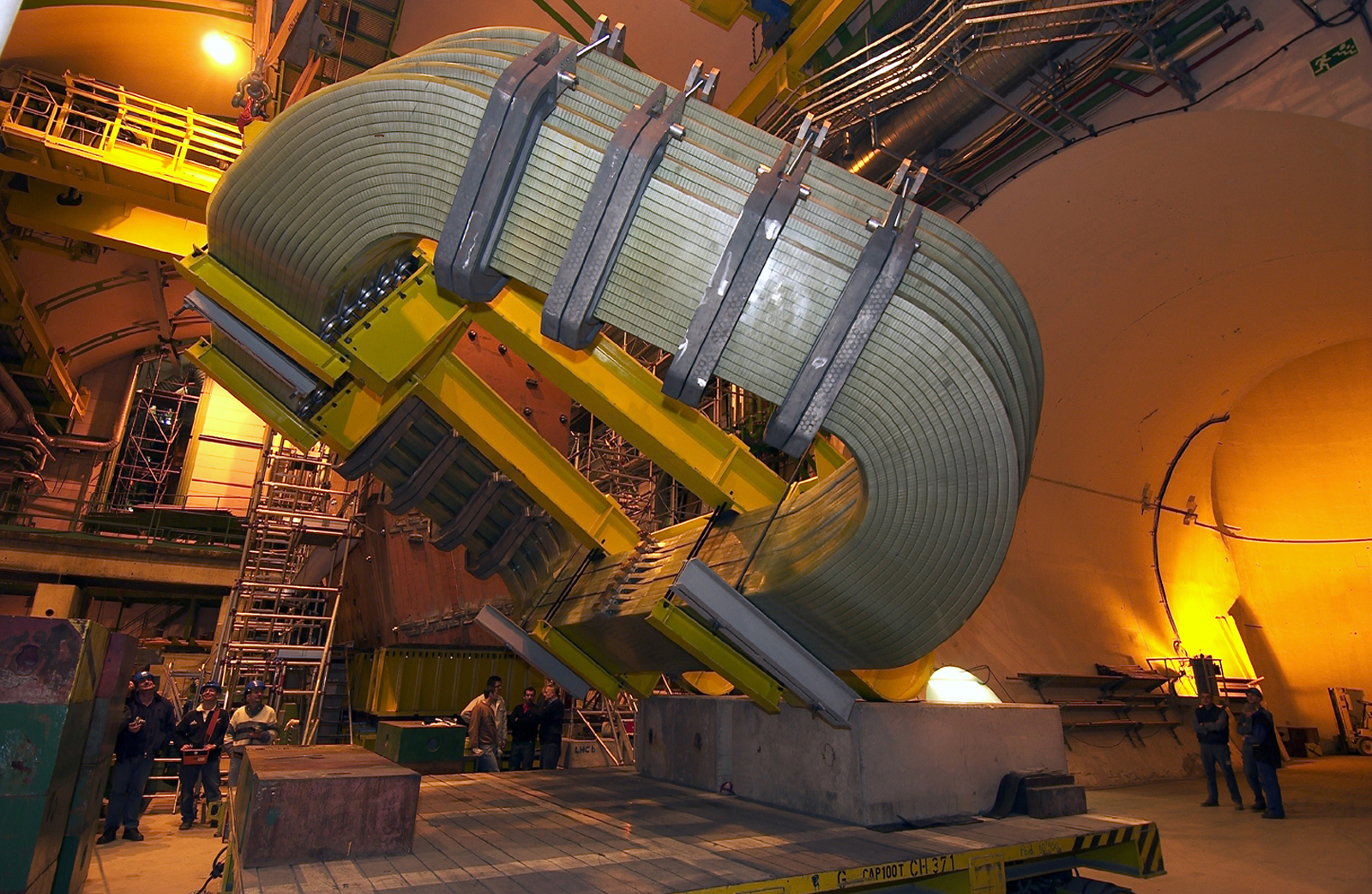Taking a closer look at LHC
|
The Lorentz Force plays another very important role in LHC. It is responsible for curving the trajectory of the new particles created after the proton collisions. According to electrical charge, mass and energy, particles trajectory will be curved to be analysed separately. The imaxe shows the generation of a Higgs particle followed of two photons which are not affected for the magnetic field. Each detector has its own design for that magnetic field, and it´s worth taking a look at LHCb and ALICE. |
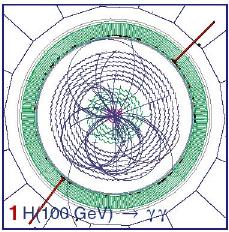 |
LHCb MAGNET.
The LHCb dipole magnet is a warm magnet and does not require cryogenic cooling.
The magnet consists of two trapezoidal coils bent at 45° on the two transverse sides, arranged inside an iron yoke of window-frame configuration. Its goals is obviously to provides magnetic fields for momentum measurements. The magnetic flux generated by the two warm coils is shaped and guided by the iron yoke. It produces a vertical magnetic field in the gap between the pole faces. The yoke consists of two identical horizontal parts including the surfaces of the pole pieces and two identical vertical parts to close the flux return. The horizontal yoke parts are arranged orthogonal to the plane of the coils.
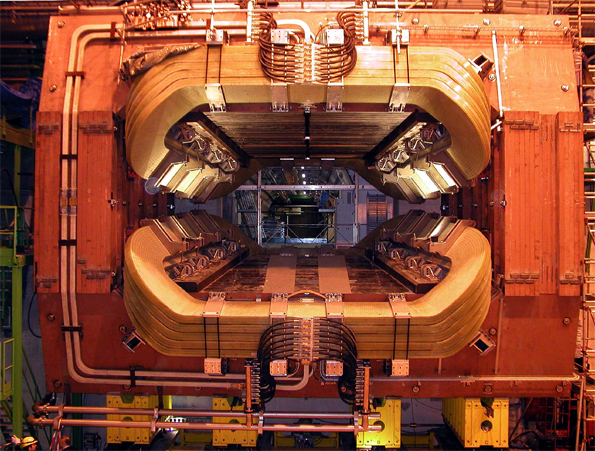
The pole faces are shaped to follow the acceptance angles of the experiments.
The choice of a warm magnet is due because it permits rapid ramping-up of the field, synchronous to the ramping-up of LHC magnets, as well as regular field inversions change of the polarity.
For reasons of costs and reliability, Aluminium was chosen as conductor material for the coils.The conductor design is based on a square conductor of 50 x 50 mm2 cross-section with a central 24 mm diameter bore for water cooling. The current intensity is 5800 A.
The coils are composed of individual pancakes, which are connected hydraulically in parallel and electrically in series. Each pancake is wound from an extruded single length conductor of about 290 m length, and is wound from an extruded conductor of sufficient length to build a mono-layer pancake of 15 turns.
So each turn is has an average length of
290:15 ≈ 19.3 m
We will take each coil as a standar circular solenoide with radius equal to:
r = 19.3/2π ⇒ r = 3 m
A coil is assembled from 15 individual mono-layer pancakes (see next image)
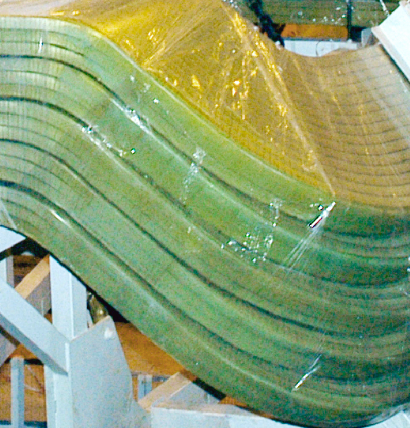
So each coil has:
15x15=225 turns.
Each conductor is 5 cm wide, so the total length of our solenoid is:
15 x 0.05=0.75 m
Taking into account all these data we can calculate some parameters of this magnet.
In the center of each solenoid the value of B is:
B = μ0·N·I/L ⇒ B = (4π·10-7·225·5800)/0.75
B ≈ 2 T
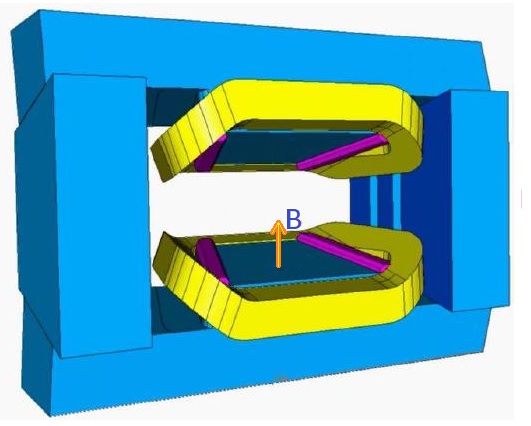
At the centre of the magnetic system, formed by the two solenoids, the value of the magnetic field created by each coil decreases, and the contribution of the two coils to the total of B in the vertical axis, at the centre of the overall system, is
B ≈ 1,1 T

The variation of the vertical field component along the beam direction (Z-axis) is shown in the below figure.
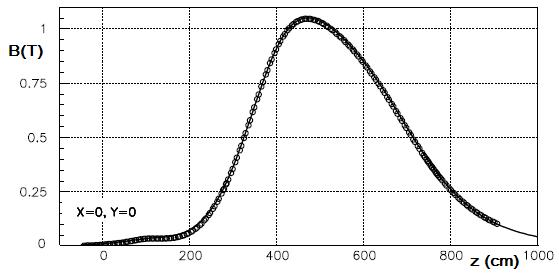
The value z=0 corresponds to the interaction point (p-p colisions). The maxim value corresponds to the center of magnet (z ~ 485 cm).
Coming back to each coil, we have:
φ = N·B·S ⇒ φ = 225·2·(π·32) ⇒ φ ≈ 12700 Wb
With, φ = L·I ⇒ L = 12700/5800 ⇒ L ≈ 2 H
The stored energy is:
E = ½·L·I2 ⇒ E = ½·2· 5800 2 ⇒ E ≈ 34 MJ
ALICE CENTRAL MAGNET.
The large solenoid magnet built for the LEP experiment L3 has been re-used as main magnet In ALICE Experiment the coil has a radius of 5.93 m an a total length of 11.90 m, and it is made of aluminum plates welded together. The 168 turn coil is divided into 28 packages, each weighing 40 tons, which are bolted together. An active thermal shield placed on the inside of the coil protects the detectors.
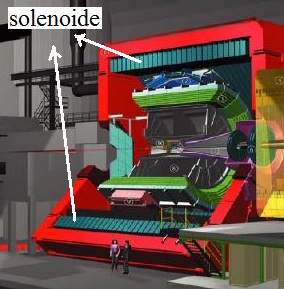
The magnetic structure is made of soft iron with 0.5% carbon content. The poles are made of 1100 tons of self-supporting structure giving the required rigidity and serving as a support and reference frame to mount the 5600 tons of _lling material, which provides the mass needed for the magnetic flux return, both in the poles and in the barrel. Each pole has two 340 ton half-doors to allow installation and removal of the muon detectors. The magnet is fed by 31 kA A, 150 V dc.
We have also to indicate that there is other important magnetic system in ALICE. This is the forward dimuon spectrometer, a single arm detector, placed outside L3 and requiring a large dipole magnet for particle tracking. This magnet will be placed adjacent to one side of the L3 solenoid (see figure in detector page).
Coming back to the solenoid, and taking into account the data above indicated, we can calculate some parameters of this magnet (as a cylinder-like shape).
In the center of the solenoid the value of B is :
B = μ0·N·I/L ⇒ B = (4π·10-7·168·31000)/11.9
B ≈ 0,55 T
The magnetic field of the Earth is 0,5 gauss, or 5·10-5 T, so the afnetic field in the center of ALICE solenoid is eleven thousand times greater.
We can also calculate the value of the magnetic flux:
φ = N·B·S ⇒ φ = 168·0,5·(π·5,932) ⇒ φ ≈ 10200 Wb
With, φ = L·I ⇒ L = 10200/31000 ⇒ L ≈ 0,33 H
The stored energy is:
E = ½·L·I2 ⇒ E = ½·0,33· 310000 2 ⇒ E ≈ 160 MJ
A Boeing 747 with a speed taxi of 110 km/h (~31 m/s), and 330 tonnes weight, has a kinetic energy:
EK = ½·m·v2 ⇒ EK = ½·330000·312 EK ~ 160 MJ
(no more comments)
|
AUTHORS Xabier Cid Vidal, PhD in experimental Particle Physics for Santiago University (USC). Research Fellow in experimental Particle Physics at CERN from January 2013 to Decembre 2015. He was until 2022 linked to the Department of Particle Physics of the USC as a "Juan de La Cierva", "Ramon y Cajal" fellow (Spanish Postdoctoral Senior Grants), and Associate Professor. Since 2023 is Senior Lecturer in that Department.(ORCID). Ramon Cid Manzano, until his retirement in 2020 was secondary school Physics Teacher at IES de SAR (Santiago - Spain), and part-time Lecturer (Profesor Asociado) in Faculty of Education at the University of Santiago (Spain). He has a Degree in Physics and a Degree in Chemistry, and he is PhD for Santiago University (USC) (ORCID). |
CERN CERN Experimental Physics Department CERN and the Environment |
LHC |
IMPORTANT NOTICE
For the bibliography used when writing this Section please go to the References Section
© Xabier Cid Vidal & Ramon Cid - rcid@lhc-closer.es | SANTIAGO (SPAIN) |



